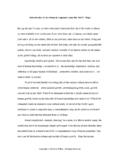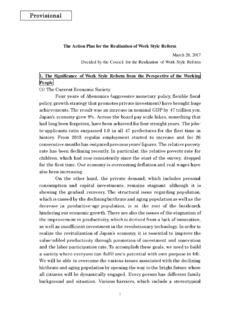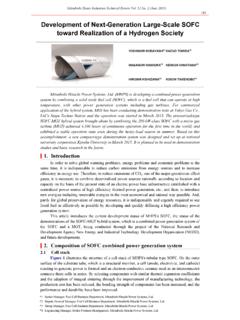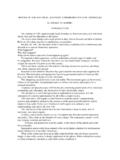Transcription of Excerpt G: Toward A Comprehensive Theory of Subtle Energies
1 Excerpt G: Toward A Comprehensive Theory of Subtle Energies Introduction The following is an Excerpt from the first draft of volume 2 of the Kosmos trilogy, tentatively titled Kosmic Karma (volume 1 of that trilogy was Sex, Ecology, Spirituality). This Excerpt suggests a coherent and Comprehensive Theory of the many approaches to Subtle Energies , their origin, nature, and development. This particular Excerpt comes Toward the end of the volume, which means that somebody reading this Excerpt will not have the benefit (or the torture) of having read the first part of the book. I will therefore present a brief introduction, followed by an integral approach to Subtle Energies . The first two excerpts from Kosmic Karma ( An Integral Age at the Leading Edge and The Many Ways We Touch ) can be found at ; they explain the general approach itself.
2 AQAL (pronounced ah-quil) is short for all quadrants, all levels, all lines, all states, all types, which is the metatheory of the integral approach, and which will be explained as we go along. Following the background Introduction (Part I), I will outline an Integral Theory of Subtle Energies (Part II), and end with a comparison with other theorists (Part IV). Copyright 2006 Ken Wilber. All Rights Reserved. 1 Part I. Introduction: From the Great Chain of Being to Postmodernism in Three Easy Steps Overview Before we look at what modern science has brought to the picture of Subtle Energies , let s look at what the great wisdom traditions have to tell us. We will then attempt to bring both of them together in an integral Theory of Subtle Energies . The traditional Great Chain of Being is usually given as something like: matter, body, mind, soul, and spirit.
3 In the Vedanta, for example, these are, respectively, the 5 sheaths or levels of Spirit: annamayakosha (the sheath or level made of physical food), the pranamayakosha (the level made of lan vital), the manomayakosha (the level made of mind), the vijnanamayakosha (the level made of higher mind or soul), and anandamayakosha (the level made of transcendental bliss or causal spirit. Vedanta, of course, adds turiya, or the transcendental ever-present Self, and turiyatita, or the nondual, ever-present, unqualifiable Spirit-as-such, but the simpler five-level scheme will work for our introductory purposes. We will return to the more complete version later.) This five-level Great Chain of Being can be represented schematically as in figure 1. Although we have to be very careful with cross-cultural comparisons, interpretive schemes similar to this Great Chain or Great Nest of Being can be found in most of the wisdom traditions of the premodern world, as indicated in figures 2 and 3, which are diagrams used by Huston Smith to indicate the general similarities (or family resemblances) among these traditions.
4 With reference to figure 1, notice that the Great Chain, as conceived by its proponents (from Plotinus to Aurobindo), is indeed more of a Great Nest or what is often called a holarchy because each senior level goes beyond its junior levels but envelopes them (or Copyright 2006 Ken Wilber. All Rights Reserved. 2 nests them) what Plotinus called a development that is envelopment. Each higher level, however, also radically transcends its juniors and can neither be reduced to its juniors nor explained by them. This is indicated in figure 1 as (A), (A + B), (A + B + C), and so on, which means that each senior level contains elements or qualities that are emergent and nonreducible. Figure 1. The Traditional Great Chain of Being For example, when life (A + B) emerges out of matter (A), it contains certain qualities (such as sexual reproduction, interior emotions, autopoiesis, lan vital, etc.)
5 All represented by B ) that cannot be accounted for in strictly the material terms of A. Likewise, when mind ( A + B + C ) emerges out of life, mind contains emergent characteristics ( C ) that cannot be reduced to, nor explained by, life and matter alone. When soul ( A + B + C + D ) emerges, it transcends mind and life and body. Evolution, then, is this unfolding of Spirit from matter to Copyright 2006 Ken Wilber. All Rights Reserved. 3 body to mind to soul to Spirit itself, or the realization of the absolute Spirit that was the Goal and Ground of the entire sequence. Figure 2. The Great Chain in Various Wisdom Traditions, compiled by Huston Smith (graphic layout courtesy of Brad Reynolds). The best introduction to this traditional notion remains Schumacher s classic A Guide for the Perplexed, a title borrowed from Maimonides s great exposition on the same topic.
6 The general idea is of a great holarchy of being and knowing, with the levels of reality in the outer world reflected in the levels of self (or levels of interior knowing and being), which is particularly suggested by figure 3. Copyright 2006 Ken Wilber. All Rights Reserved. 4 Figure 3. As Above, So Below (from Huston Smith, Forgotten Truth; reprinted with permission.) But, according to the traditions, this entire process of evolution or un-folding could never occur without a prior process of involution or in-folding. Not only can the higher not be explained in terms of the lower, and not only does the higher not actually emerge out of the lower, but the reverse of both of those is true, according to the traditions. That is, the lower dimensions or levels are actually sediments or deposits of the higher dimensions, and they find their meaning because of the higher dimensions of which they are a stepped-down or diluted version.
7 This sedimentation process is called involution or emanation. According to the traditions, before evolution or the unfolding of Spirit can occur, involution or the infolding of Spirit must occur: the higher successively steps down into the lower. Thus, the higher levels Copyright 2006 Ken Wilber. All Rights Reserved. 5 appear to emerge out of the lower levels during evolution for example, life appears to emerge out of matter because, and only because, they were first deposited there by involution. You cannot get the higher out of the lower unless the higher were already there, in potential sleeping, as it were waiting to emerge. The miracle of emergence is simply Spirit s creative play in the fields of its own manifestation. Thus, for the traditions, the great cosmic game begins when Spirit throws itself outward, in sport and play (lila, kenosis), to create a manifest universe.
8 Spirit loses itself, forgets itself, takes on a magical fa ade of manyness (maya) in order to have a grand game of hide-and-seek with itself. Spirit first throws itself outward to create soul, which is a stepped-down and diluted reflection of Spirit; soul then steps down into mind, a paler reflection yet of Spirit s radiant glory; mind then steps down into life, and life steps down into matter, which is the densest, lowest, least conscious form of Spirit. We might represent this as: Spirit-as-spirit steps down into Spirit-as-soul, which steps down into Spirit-as-mind, which steps down into Spirit-as-body, which steps down into Spirit-as-matter. These levels in the Great Nest are all forms of Spirit, but the forms become less and less conscious, less and less aware of their Source and Suchness, less and less alive to their ever-present Ground, even though they are all nevertheless nothing but Spirit-at-play.
9 If we can represent the major emergent stages in evolution as (A), (A + B), (A + B + C), and so on where the addition signs mean that something is emerging or being added to manifestation then we could represent involution as the prior subtraction process: Spirit starts out full and complete, with all of manifestation contained as potential in itself, which we can represent in brackets: [A + B + C + D + E]. Spirit first steps down into manifestation and begins to lose itself in manifestation by shedding its pure spiritual nature and assuming a manifest, finite, limited form namely, the soul [A + B + C + D]. The soul has now forgotten E, or its radical identity with and as Spirit, and, in the ensuing confusion and angst, the soul flees this terror by stepping down into mind [A + B + C], which has forgotten D, its soul Copyright 2006 Ken Wilber.
10 All Rights Reserved. 6 radiance; and mind flees into life, forgetting C, or its intelligence; and finally life sheds even its vegetative vitality B and appears as inert, insentient, lifeless matter, A at which point something like the Big Bang occurs, whereupon matter blows into concrete existence and it appears that in the entire manifest world, there exists nothing but insentient, dead, lifeless matter. But this matter is curiously frisky, is it not? It doesn t just seem to lie about, on unemployment insurance, watching TV. This matter astonishingly begins to wind itself up: order out of chaos is what complexity physics calls it or dissipative structures, or self-organization, or dynamic becoming. But the traditionalists were more straightforward about it: God does not remain petrified and dead; the very stones cry out and raise themselves to Spirit, as Hegel put it.











